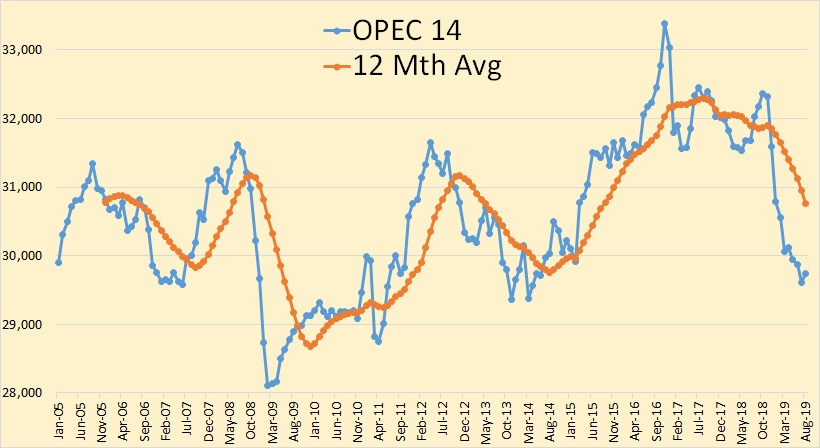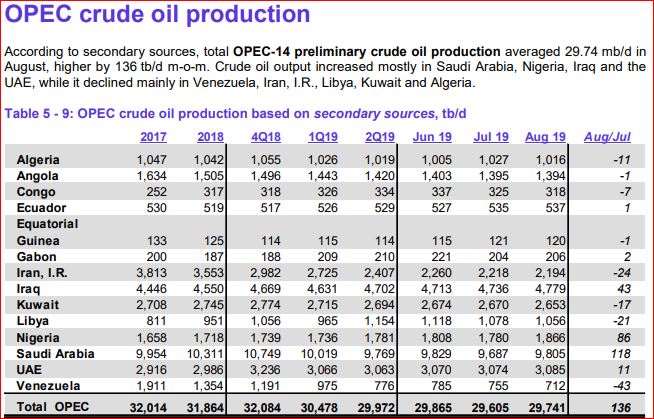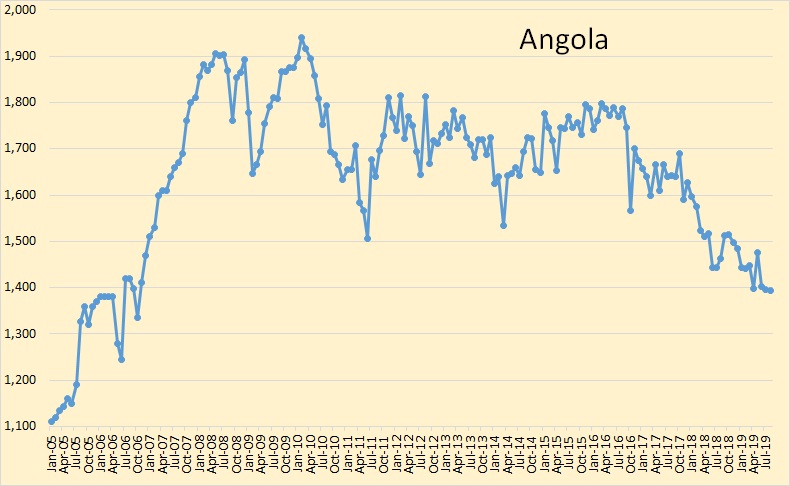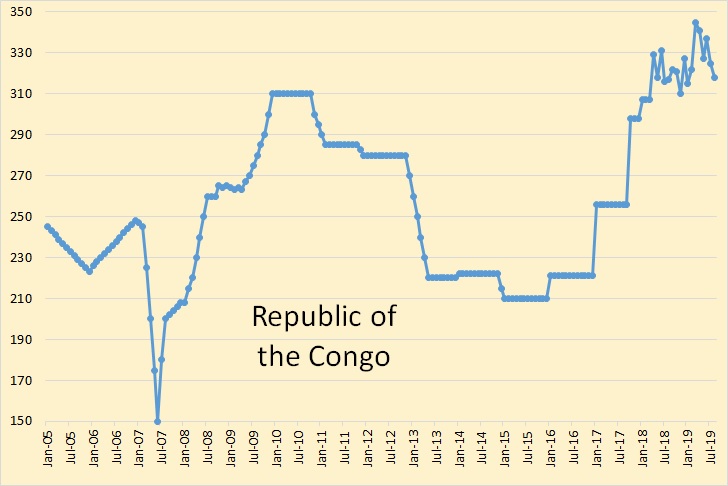Home » Posts tagged 'opec' (Page 4)
Tag Archives: opec
Oil Crashes After Reports OPEC+ Talsk End Without A Deal
Oil Crashes After Reports OPEC+ Talsk End Without A Deal
Update (1015ET): Reports, citing a delegate, for the first time in six years, OPEC ends talks in Vienna without a deal. being agreed. Oil prices are extending their collapse…
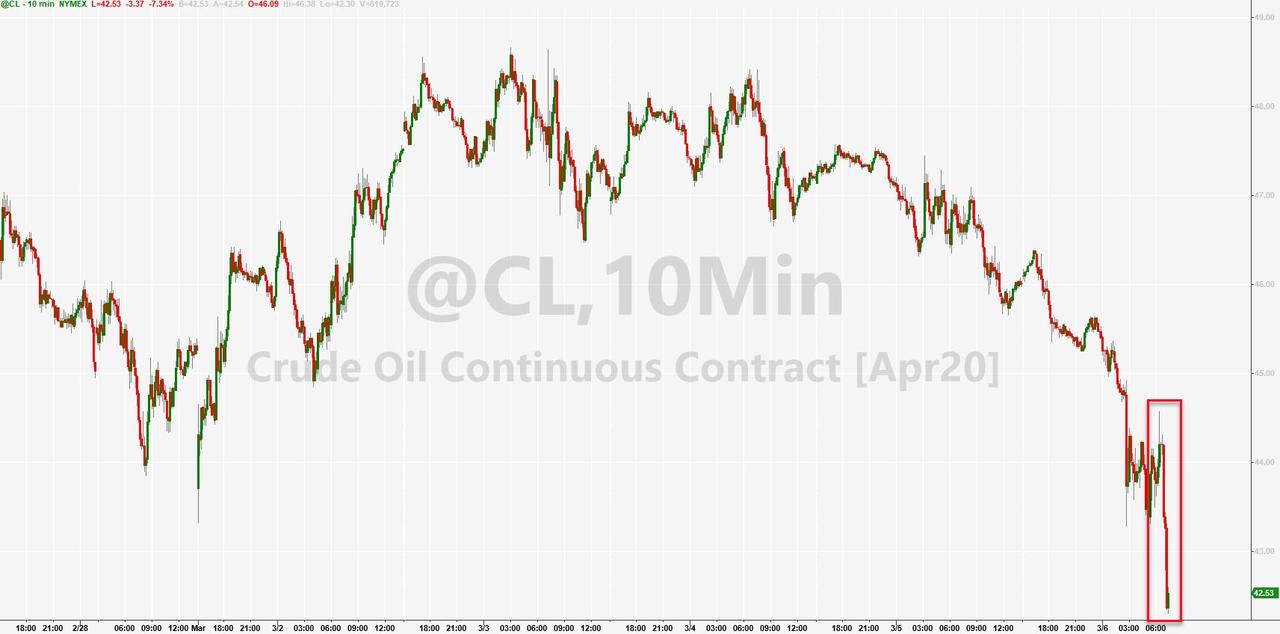
* * *
Update (0950ET): Bloomberg reports that OPEC+ talks “are on the verge of collapse” as it becomes clear that Russia will not agree (and in fact disagrees with their usefulness) to further production cuts, and in fact will not agree to extend the duration of the current production cuts.
WTI just hit a $42 handle…
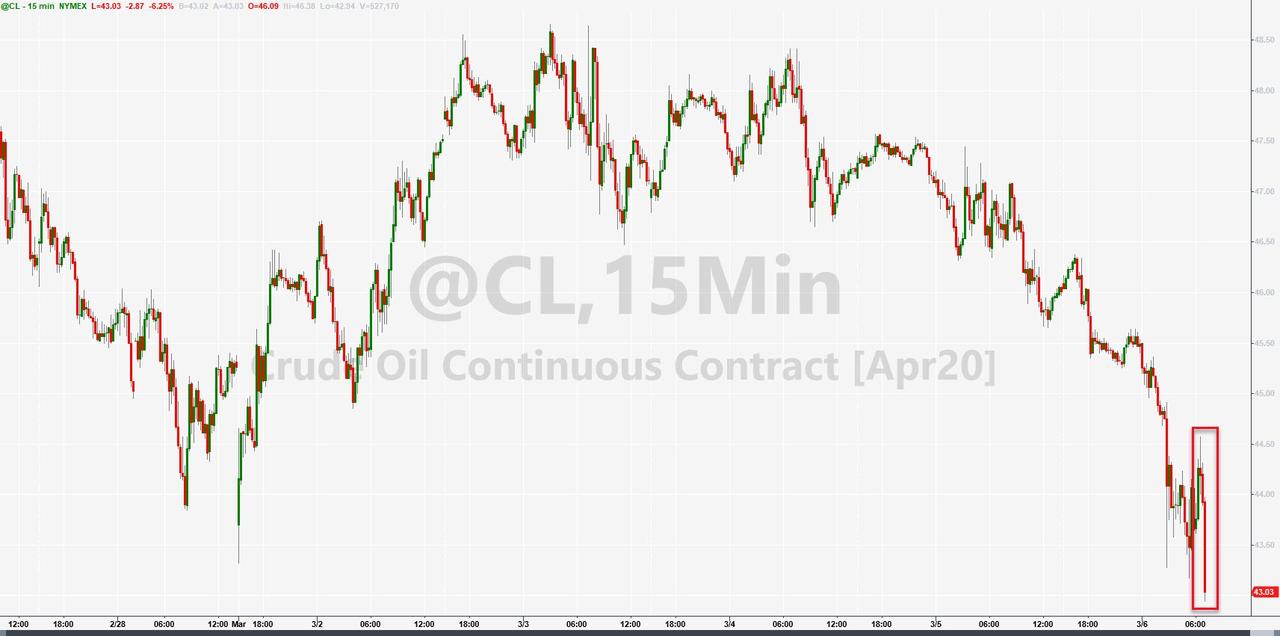
Some context for just how bad this is…
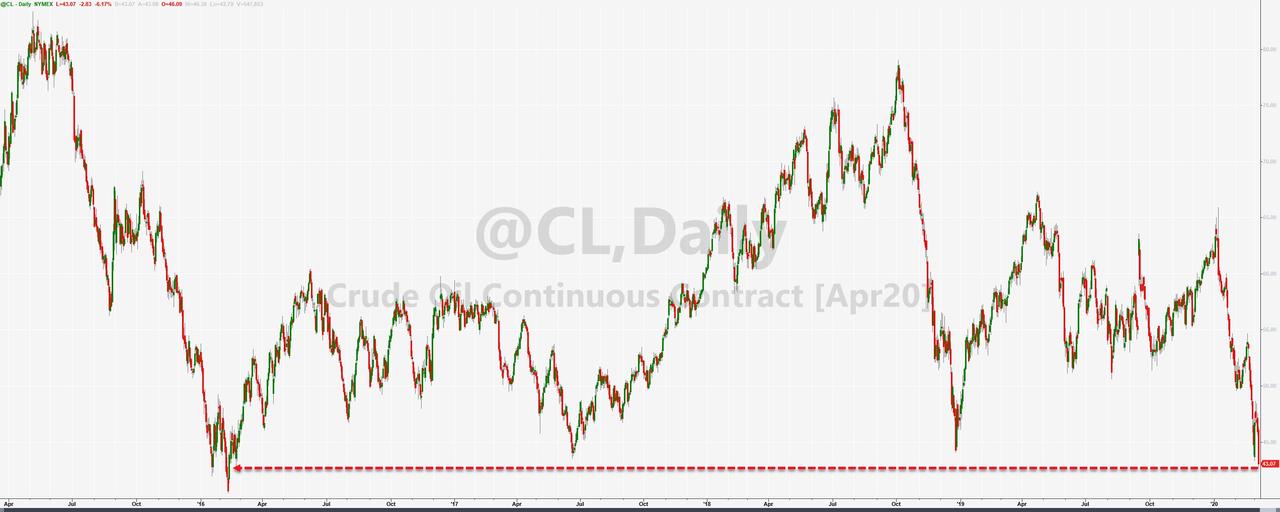
And OPEC+ have been “managing” this for years?
* * *
Update (0815ET): Russia says it is ready for a decline in oil prices. It said OPEC+’s proposed deeper production cuts aren’t a solution to rebalancing the global oil market amid a collapse in demand.
* * *
Brent crude futures tumbled by more than 4% on Friday after Reuters reported that Russia had rejected steep production cuts by OPEC to prop up oil prices amid the Covid-19 outbreak triggering demand shocks in China and across the world.
A high-level Russian source told Reuters that Moscow has no interest in backing an OPEC reduction that calls for extended cuts and would only agree to existing cuts that OPEC already agreed on.
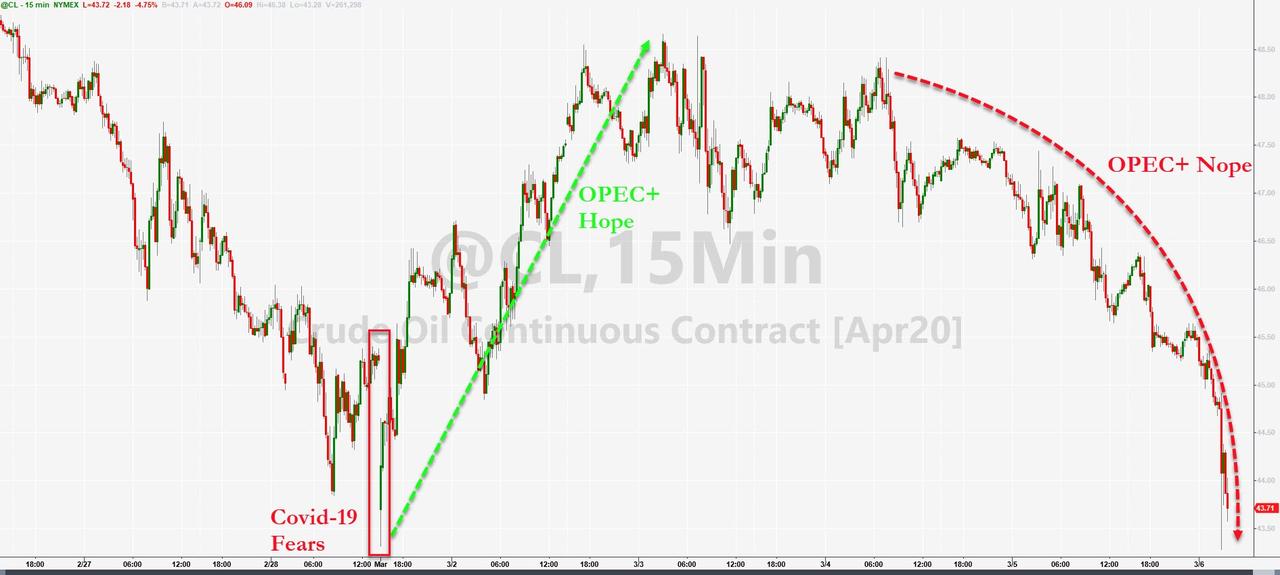
OPEC has held several days of talks in Vienna, Austria, backing an additional 1.5 million barrels per day (bpd). However, it has failed to bring Russia on board. OPEC wants non-OPEC to contribute 500,000 bpd to the overall cut. The new deal would mean OPEC+ would cut a total of 3.6 million bpd, a move that would hopefully lead to a rebalancing in the global oil market in the second half of the year. On Russain disappointment, Brent crude futures dropped to its lowest level since July 2017, trading at $47.70 a barrel, or down 4.5% on Friday morning.
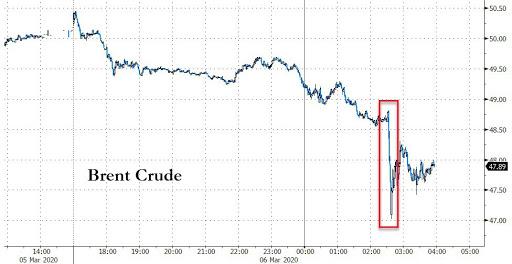
…click on the above link to read the rest of the article…
“No Deal In Sight” – Oil Plunges After Russia Rejects Additional OPEC+ Cut
“No Deal In Sight” – Oil Plunges After Russia Rejects Additional OPEC+ Cut
Brent crude futures tumbled by more than 4% on Friday after Reuters reported that Russia had rejected steep production cuts by OPEC to prop up oil prices amid the Covid-19 outbreak triggering demand shocks in China and across the world.
A high-level Russian source told Reuters that Moscow has no interest in backing an OPEC reduction that calls for extended cuts and would only agree to existing cuts that OPEC already agreed on.

OPEC has held several days of talks in Vienna, Austria, backing an additional 1.5 million barrels per day (bpd). However, it has failed to bring Russia on board. OPEC wants non-OPEC to contribute 500,000 bpd to the overall cut. The new deal would mean OPEC+ would cut a total of 3.6 million bpd, a move that would hopefully lead to a rebalancing in the global oil market in the second half of the year. On Russain disappointment, Brent crude futures dropped to its lowest level since July 2017, trading at $47.70 a barrel, or down 4.5% on Friday morning.

Another source, this time with Bloomberg, said that Russia wants OPEC+ to sustain current output cuts until June. It would then be at that time where more data about market imbalances could be assessed and corrected, the person added.
With Russia taking a “tough stance” on the proposed additional cuts, Commerzbank says Brent futures could extend declines to $40 per barrel. However, if Russia agrees to further cuts, Brent futures would jump to $60 in weeks.
Goldman Sachs maintained its Brent price forecast of $45 per barrel in April.
“Ultimately, a rebound in demand, not supply cuts, will be the necessary catalyst for a sustainable rebound in prices,” Goldman said.
…click on the above link to read the rest of the article…
OPEC Agrees To 1.5MM Barrel Output Cut, But Fails To Obtain Critical Russian Backing
OPEC Agrees To 1.5MM Barrel Output Cut, But Fails To Obtain Critical Russian Backing
Today’s OPEC meeting has been more of a stunt by members to persuade Russia to agree to deep cuts amid a demand shock triggered by the Covid-19.
Ministers from OPEC agreed on a large cut of 1.5 million barrels per day in the second quarter to support prices but made it conditional on Russia joining in, said two OPEC sources, who were cited by Reuters.
Brent crude futures have soared between 6-10% in the last four sessions on OPEC+ JMMC technical committee recommendation, which stated cuts between 750,000 to 1 million barrels per day are needed to stabilize prices. Demand destruction from China and aboard has been one of the most significant shocks to hit global oil markets since the financial crisis a decade ago.
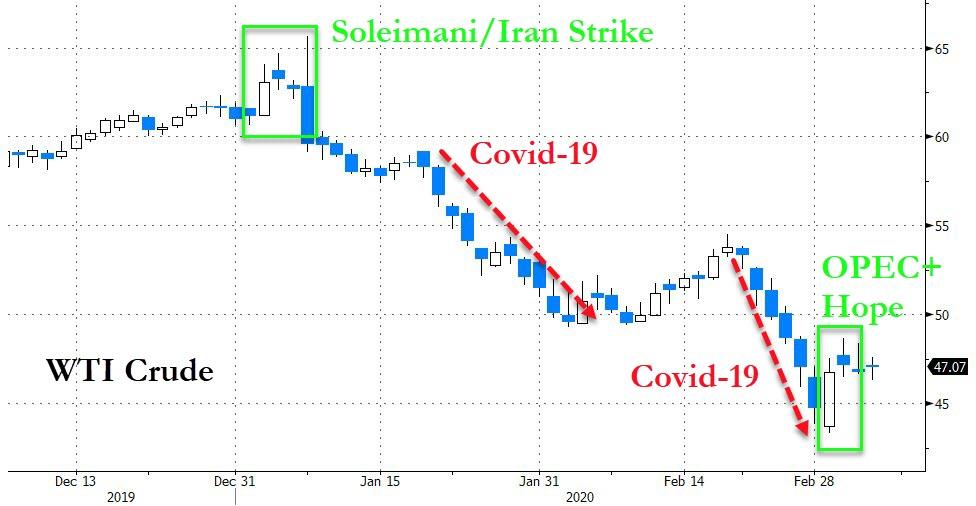
Reuters notes that Saudi Arabia, the largest producer in OPEC, has yet to win the support of Russia agreeing on the cuts.
But that didn’t stop the algos bidding oil higher…
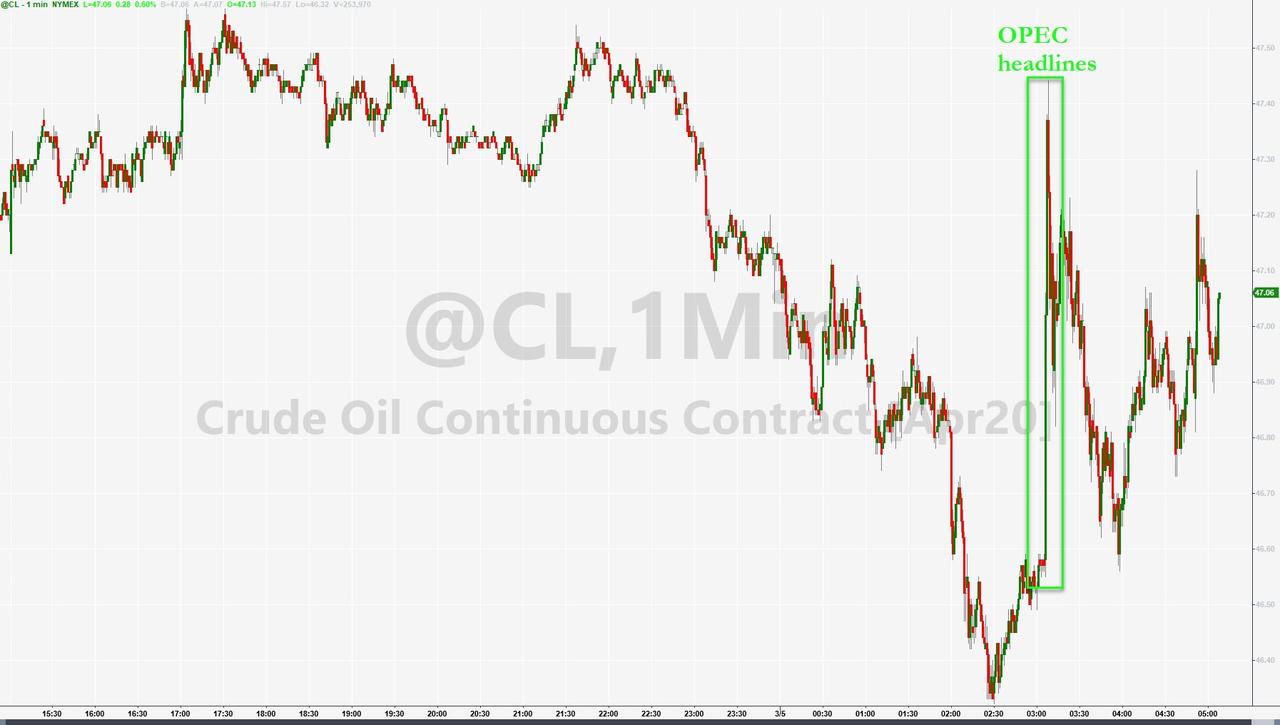
Moscow, which has worked with OPEC+ since 2016 to balance supply, has so far withheld its support for a reduction in output.
Russia’s energy minister left OPEC meetings in Vienna on Wednesday, expected to return on Friday for more in-depth talks.
“Our expectation is that OPEC+ will deliver a credible and coherent strategy that will take more barrels than what’s priced into the market off the table,” Mitsubishi UFG’s Ehsan Khoman told Reuters.
Russia could capitulate on Friday, as it has done everything so far to drag out production cut talks. Still, as we noted yesterday, “Russia will decide on production cuts at the very last minute.”
Saudis Urge More Than 1 Million Bpd Oil Cut To Prop Up Prices, Russia Opposes
Saudis Urge More Than 1 Million Bpd Oil Cut To Prop Up Prices, Russia Opposes
Update (0800ET): The Wall Street Journal reports that Russia opposes the Saudi plan to deepen OPEC+ cuts by 1.2mm b/d.
Developing…
* * *
As we detailed earlier, Brent crude futures were up 75 cents, or 1.45%, at 52.61 a barrel at 0700ET Wednesday after a three-day move of +10%, following expectations that major oil producers could make significant production cuts at the OPEC meeting on March 5.
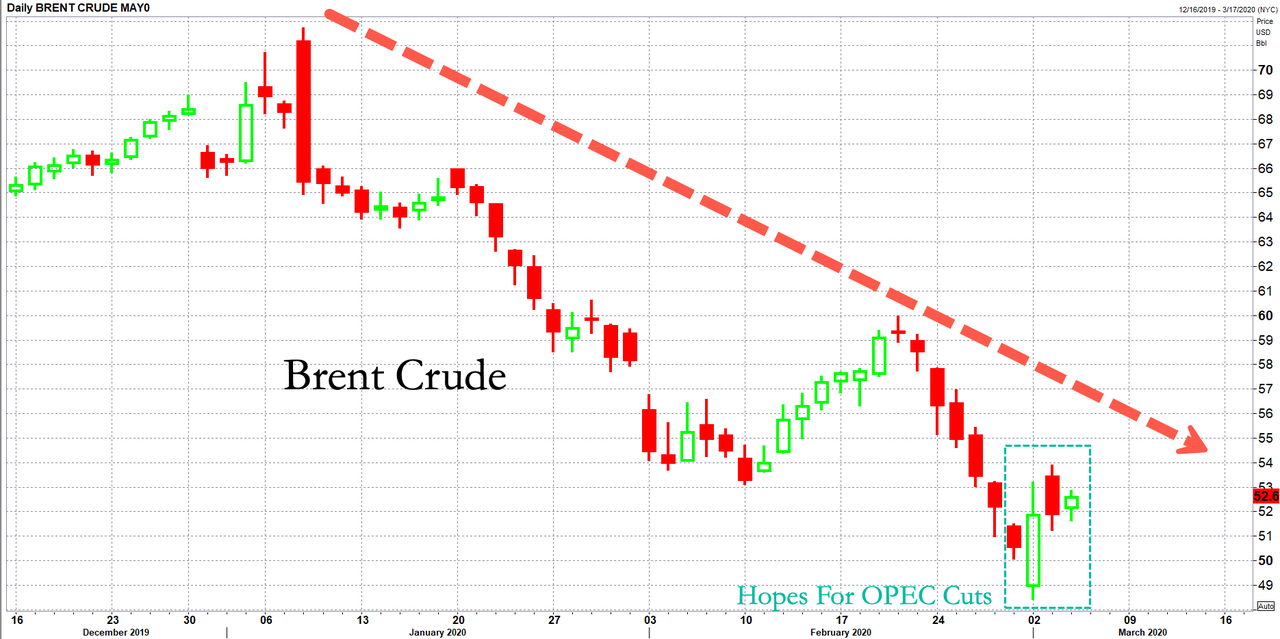
Brent has tumbled into a bear market, down 26.5% in 38 sessions, following the outbreak of Covid-19 in China, now spreading across the world, has slashed global oil demand.
“This is a sudden, instant demand shock,” said Jim Burkhard, vice president and head of oil markets at IHS Markit Ltd.
“The scale of the decline is unprecedented.”
OPEC+ Joint Ministerial Monitoring Committee, the body that oversees production, will meet on Wednesday, ahead of the formal meeting, to discuss cuts. Saudi Arabia is urging OPEC+ to come to an agreeance ahead of Thursday for a reduction of 1 million barrels per day to compensate for lost demand seen by the virus crisis, Bloomberg notes.
“The recommended 600,000-barrel-a-day additional cut for the second quarter of 2020 will be seen as too little,” Mohammad Darwazah of consultant Medley Global Advisors said in a note. “It is clear that the group is mulling a deeper production pullback.”
The push for deep cuts comes as crude had its worst weekly decline since the 2008 financial crisis on mounting macroeconomic headwinds developing because of the virus spread, which forced Saudi Arabia to demand Russia jump on board with production cuts.
…click on the above link to read the rest of the article…
OPEC Slashes Oil Demand Forecast On Coronavirus Crunch
OPEC Slashes Oil Demand Forecast On Coronavirus Crunch
Perhaps buoyed by speculation that oil demand in China is set to plunge as much as 20% if not more on the coronavirus “demand shock”, on Tuesday OPEC slashed it forecast for global oil demand by almost a quarter million barrels per day as the coronavirus pandemic cripples fuel use in China, leaving the cartel facing a renewed glut despite its recent production cuts.
The cartel reduced projections for demand growth in the first quarter by 440,000 barrels a day, or about a third, in its monthly report, and 230,000 for the full year, one day after oil prices sank to a one-year low on Monday as the infection has idled thousand of businesses and left millions quarantined in the world’s biggest crude importer.
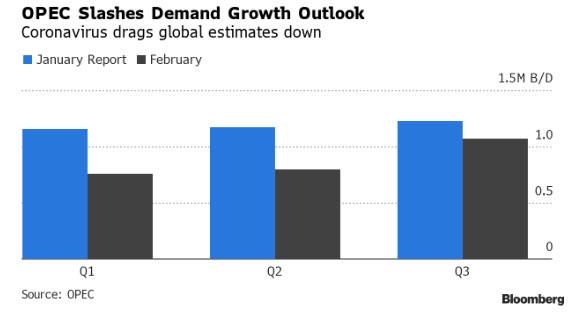
The plunge in oil prices has sparked a push by OPEC’s top exporter, Saudi Arabia, to push for an emergency meeting and consider new output cutbacks, following a recent Vienna meeting that ended without a consensus after Russia – the biggest non-OPEC producer – refused to comply with further cuts as it is able to weather lower prices more easily.
Ominously for Riyadh, the latest OPEC report showed that, even though many OPEC members made a strong start with fresh output curbs that took effect last month, the overhang from the virus will leave them with an even greater surplus. The group collectively pumped 28.86 million barrels a day in January, down 509,000 on the month, and if it maintains that rate there will be a surplus of 570,000 barrels a day during the second quarter, when consumption slows down seasonally.
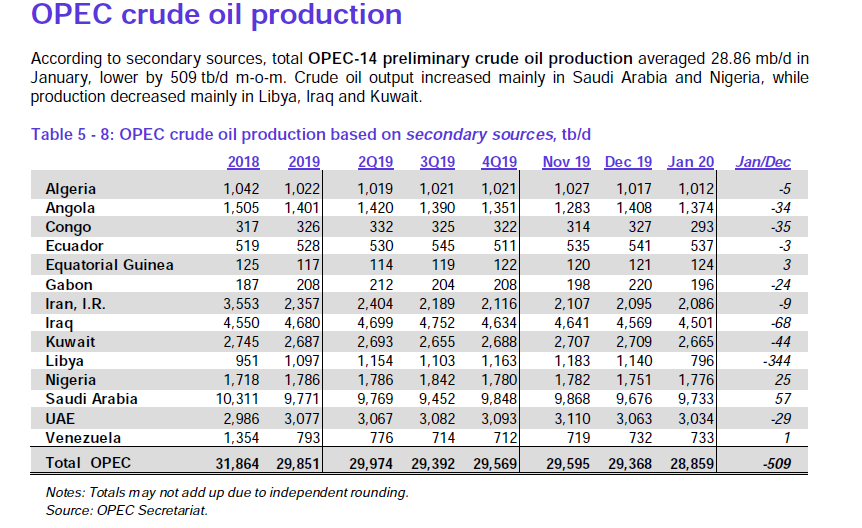
…click on the above link to read the rest of the article…
OPEC+ Committee Fails To Agree On Proposed Production Cuts
OPEC+ Committee Fails To Agree On Proposed Production Cuts
Oil futures remain in a bear market following the collapse in oil demand from China amid two-thirds of its economy shutdown following the coronavirus outbreak.
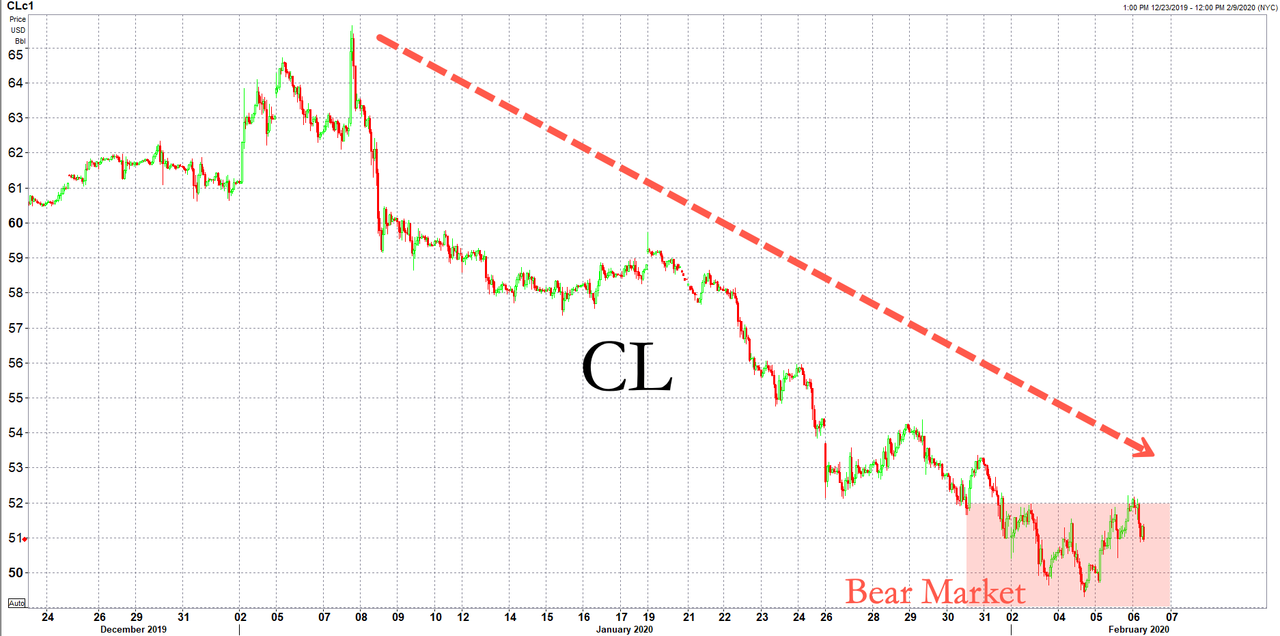
This forced the OPEC+ technical committee to meet in Vienna, Austria, for a third day this week, to discuss the importance of slashing oil output by at least 500,000 barrels per day (bpd), reported Reuters.
The Joint Technical Committee (JTC) is an advising body of OPEC and Russia, known as OPEC+.
As of Thursday, there’s no firm decision by the technical committee to cut oil production. This is because Russia has opposed to cuts and said it would be willing to agree on an extension of current cuts.
Ransquawk reports that the meeting has officially ended without a planned resolution of production cuts.
The technical committee meeting comes ahead of a planned OPEC+ conference on March 5-6.
OPEC+ has already agreed in December to remove 1.7 million bpd from markets in response to a slowing global economy. Now the deadly virus outbreak has created a “shock” in the global economy as China’s economy grinds to a halt. The country is the largest importer of crude in the world, suggesting that demand has collapsed, and oil prices will plunge deeper if supply isn’t curbed.
Russian Energy Minister Alexander Novak said on Tuesday that he wasn’t sure if it was time to tighten output further.
BP CFO Brian Gilvary warned Tuesday that the virus outbreak has reduced 2020 global demand growth by 300,000-500,000 bpd, or about 0.5%.
…click on the above link to read the rest of the article…
Saudi Arabia Pushes For OPEC Production Cut Of Up To 1 Million B/d As Outbreak Weighs On Demand
Saudi Arabia Pushes For OPEC Production Cut Of Up To 1 Million B/d As Outbreak Weighs On Demand
Half of China’s economy – the second largest in the world – is expected to be offline through at least mid-February. Traders started pricing in the impact on oil demand weeks ago. And now that it’s become clear to everybody that this problem isn’t going away any time soon, and after oil prices recorded their largest monthly drop in 30 years, OPEC might step in to ‘re-balance’ the global energy market.
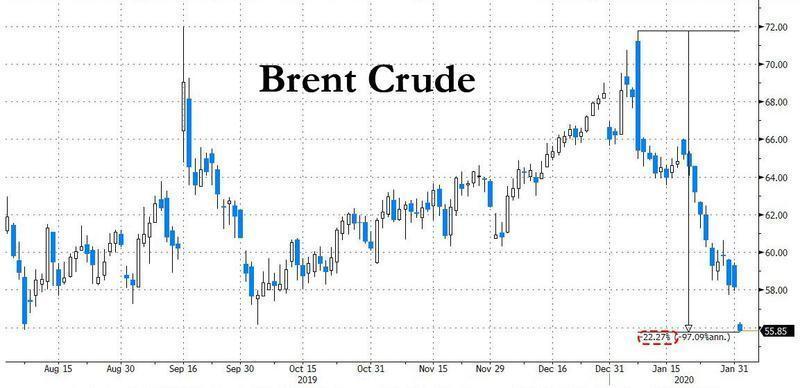
Confirming earlier whispers, Saudi Arabia is reportedly pushing for a major, short-term oil production cut, WSJ reported Monday morning, citing anonymous OPEC officials.
A group of OPEC countries and their allies – collectively known as OPEC+ – are planning to meet Tuesday and Wednesday to debate possible action thanks to the outbreak in China, the world’s largest oil importer and consumer.
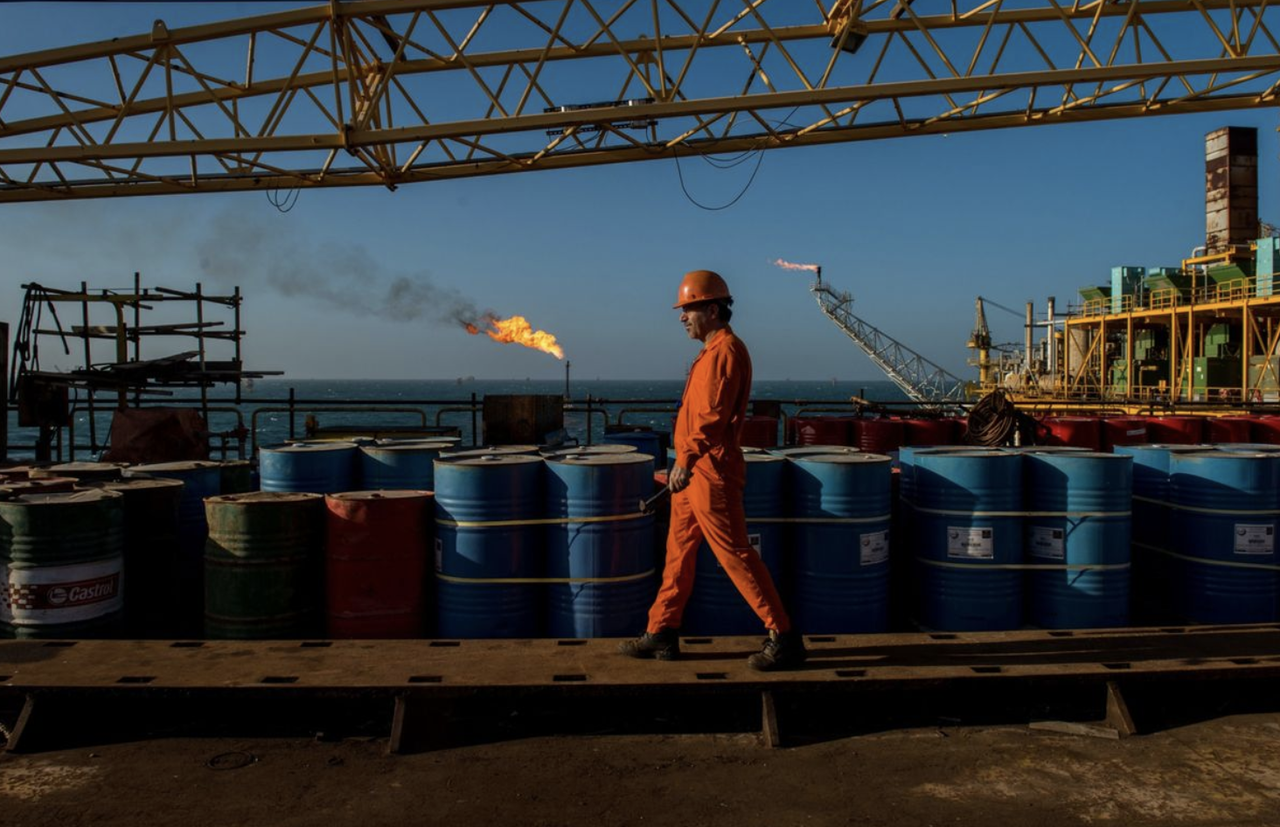
One scenario being discussed is that Saudi Arabia, OPEC’s kingpin, would lead a collective reduction of 500,000 barrels a day. The production cut will remain in place until the outbreak has subsided, cartel officials said.
Another, more drastic, option being considered would involve a temporary cut of 1 million b/d, a cut that would deliver a decisive ‘jolt’ to the market (and potentially trigger another flurry of angry Trump tweets about oil prices – the ‘invisible tax’ – being too high.
…click on the above link to read the rest of the article…
Russia Bets Big On The World’s Least Explored Oil Frontier
Russia Bets Big On The World’s Least Explored Oil Frontier

When the inaugural Russia-Africa summit was held in October 2019, most industry observers believed that the majority of projects under discussion would not get past the FID stage – in no small part because of their varied economic prospects. As well as wheat exports, nuclear technologies, conventional weaponry and ore mining, oil loomed large on the agenda. With the OPEC+ agreement entering its third consecutive year and oil prices stabilizing around $60 per barrel, Russian oil firms have enough cash to invest but face an uncertain future with domestic projects as no one really wants to see their own project ending up in the category of “spare production capacity”.
International sanctions and the ramifications they entail have compelled Russia to look beyond their usual investment regions – with little to no investments in Europe since 2014. Gazprom is now an unwelcome investor in Europe and even the privately-owned LUKOIL has mulled divesting its downstream assets and has reduced its retail presence in Europe. Investing in the United States or Canada is completely out of question for reasons predominantly political, whilst Middle Eastern NOCs have grown to become competitors, themselves looking for opportunities to diversify their portfolio. Due to all of the above factors, Africa has emerged somewhat naturally as a suitable region for Russian investment.
The Russian Energy Ministry has repeatedly declined to link Russia’s newly-found interest in Africa and the OPEC+ curtailments, saying that greenfield projects usually require 5-7 years before commissioning and thus the time gap between today’s issues and future production is too wide to impact any forecasts.
…click on the above link to read the rest of the article…
2020 Will Be A Crucial Year For Oil
2020 Will Be A Crucial Year For Oil

It’s the start of a new year and a new decade, and the oil market is as unpredictable as ever.
Will OPEC+ extend its cuts? Will U.S. shale finally grind to a halt? Is this the “year of the electric vehicle”? Here are 10 stories to watch in 2020.
Shale debt, shale slowdown. The debt-fueled shale drilling boom is facing a reckoning. Around 200 North American oil and gas companies have declared bankruptcy since 2015, but the mountain of debt taken out a few years ago is finally coming due. Roughly $41 billion in debt matures in 2020, which ensures more bankruptcies will be announced this year. The wave of debt may also force the industry to slam on the breaks as companies scramble to come up with cash to pay off creditors.
Year of the EV. Some analysts say that 2020 will be the “year of the EV” because of the dozens of new EV models set to hit the market. In Europe, available EV models will rise from 100 to 175. The pace of sales slowed at the end of last year, but the entire global auto market contracted. EVs may struggle to keep the pace of growth going, but EVs are capturing a growing portion of a shrinking pie.
Climate change. 2020 starts off with hellish images from the out-of-control Australian bushfires. 2019 was one of the warmest years on record and the 2010s was the warmest decade on record. As temperatures rise and disasters multiply, pressure will continue to mount on the oil and gas industry. As Bloomberg Opinion points out, climate change has surged as a point of concern for publicly-listed companies. Oil executives are betting against climate action, but they are surely aware of the rising investment risk. In the past two months, the European Investment Bank is ending financing for oil, gas and coal, and Goldman Sachs cut out financing for coal and Arctic oil. More announcements like this are inevitable.
…click on the above link to read the rest of the article…
Uncertainties following the Abqaiq attack have shrunk the world’s safe oil reserves by around half (part 1)
Uncertainties following the Abqaiq attack have shrunk the world’s safe oil reserves by around half (part 1)
The world has returned to business as usual after the Saudis assured oil markets that production will be back soon and as oil prices have returned to pre-attack levels and even lower, indicating that oil traders focus on a weak global economic outlook.
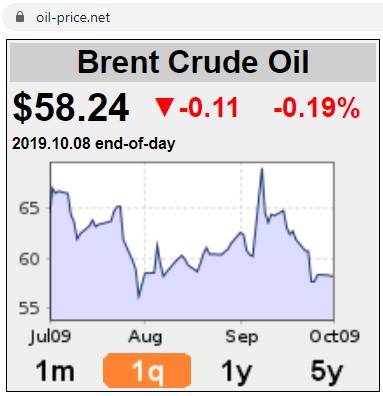
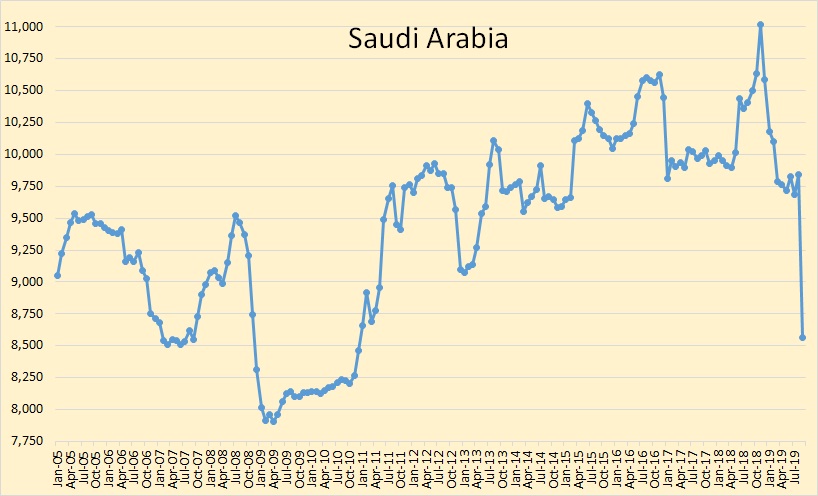
The peak oil barrel blog monitors OPEC’s oil production and published the above graph for September 2019, using data from OPEC’s Monthly Oil Market Report. The drop from around 9,800 kb/d to 8,500 kb/d translates into an approximate loss in September of 40 mb Arab Light. Saudi oil stocks were 180 mb before the attack. Maybe tanks are filled with partially processed oil with a high sulfur content.
Iran’s oil exports
From the IEA Monthly Oil Market Report dated 12/9/2019 (2 days before the Abqaiq attack):
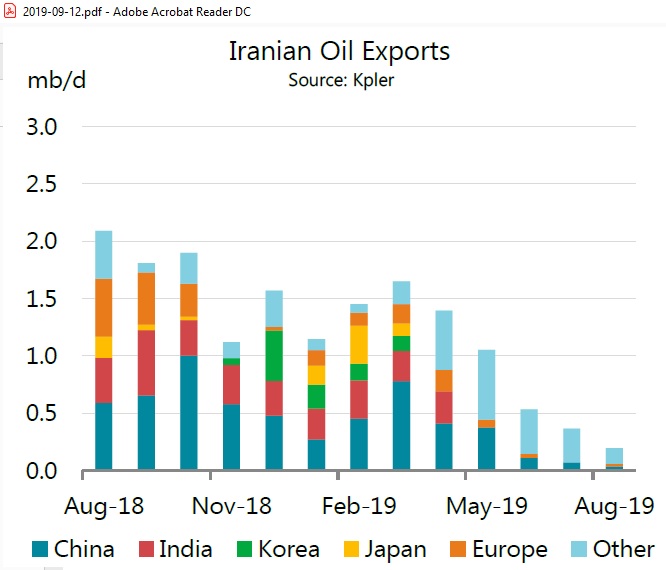
The data on Iranian oil exports are fuzzy. On 13 Sep 2019 S&P Global Platts reported 424 kb/d in August (mainly to China and Syria) but warns that Iranian storage is filling up quickly, including 50 mb on tankers (mostly condensate). During the last round of sanctions in 2016 storage reached 55-60 mb.
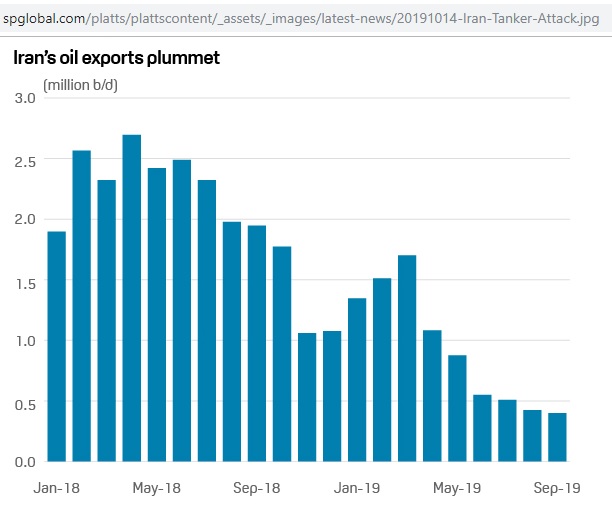
In July 2019 the Atlantic Council calculated in an article entitled
Iran’s Crude Oil Exports: What Minimum Is Enough to Stay Afloat?
that Iran needs to export 1.5 mb/d to balance the budget and 720 Kb/d as an absolute minimum in survival mode (withdrawals from the National Development Fund, foreign exchange and gold reserves)
Changed balance of power in Middle East
As Iranian oil exports have dropped below these thresholds, attacks have intensified:
12 May: Fujairah, UAE, 4 tankers damaged in Gulf of Oman by limpet mines
…click on the above link to read the rest of the article…
Oil Discoveries Hit 70-Year Low
Oil Discoveries Hit 70-Year Low

The last three years has been the worst stretch of time in seventy years for new conventional oil discoveries.
A new report from IHS Markit finds that conventional oil discoveries plunged to a seven-decade low and “a significant rebound is not expected.” Conventional exploration – as opposed to unconventional development, including shale – had already been trending down following the 2008 global financial crisis and its aftermath, which overlapped with the rise of horizontal drilling and hydraulic fracturing in several U.S. shale basins.
But the collapse of oil prices in 2014 really knocked conventional exploration – and thus, discoveries – on its back.
After OPEC refrained from cutting production in the face of a swelling supply surplus in late 2014, prices fell sharply…and continued to fall for much of the next year and a half. WTI bottomed out in early 2016 below $30 per barrel, before a pullback in drilling and production cuts by OPEC+ led to a more durable price rebound beginning in 2017.
But the multi-year downturn hit conventional exploration in multiple ways. Not only were companies slashing spending and cancelling riskier ventures, but the oil majors and investors began to view short-cycle shale drilling as inherently less risky. That was because drilling was quick – companies were able to turn projects around in a matter of weeks or months, not the years that large-scale conventional projects took, particularly those offshore in deepwater. Capital flowed en masse from conventional to unconventional development.
Predictably, that led to a steep rise in U.S. shale output, while simultaneously leading to a sharp contraction in conventional discoveries. “One of the main drivers here is the shift of investment by US independents from international exploration to shale opportunities in the United States—shorter cycle-time projects—with greater flexibility to respond to changing market conditions,” Keith King, senior advisor at IHS Markit and author of the report, said in a statement.
…click on the above link to read the rest of the article…
Our Energy and Debt Predicament in 2019
Our Energy and Debt Predicament in 2019
Many people are concerned that we have an oil problem. Or they are concerned about recession and the need to lower interest rates.
As I see the situation, we have a problem of a networked economy that is not functioning well. A big part of this problem is energy-related. Strange as it may seem, energy prices (including oil prices) are too low for producers. If debt levels were growing more rapidly, this low-price problem would go away.
The “standard way” of encouraging more debt-based purchases is by lowering interest rates. But we are running out of room to do this now. We also seem to be running out of economic investments to make with debt. If expected returns on investment were greater, interest rates would be higher.
Without economic investments, demand for commodities of all kinds, including energy products, tends to stay too low. This is the problem we have today. Our debt problem and our energy problem are really different aspects of a networked economy that is no longer generating enough total return. History suggests that these periods tend to end badly.
In the following sections, I will explain some of the issues involved.
[1] Our problem is not just that oil prices that are too low. Prices are too low for practically every type of energy producer, and in many parts of the globe.
Oil: OPEC oil producers have cut back production because they view oil prices as too low. OPEC reports a cutback in production of 2.7 million barrels per day between November 2018 and July 2019 (from 32.3 million bpd to 29.6 million bpd).
In the US, there has been an increase in bankruptcies of oil producers during 2019, relative to 2018. There has also been a reduction in the number of oil drilling rigs of 17% since the week of November 16, 2018, according to reports by Baker Hughes. These are signs of producer distress.
…click on the above link to read the rest of the article…
BP Is The Latest Major Oil Company To Shutter Operations In Alaska
BP Is The Latest Major Oil Company To Shutter Operations In Alaska
Yet another major oil company has backed away from one of the frontier oil discoveries of the late 20th century that not only cushioned them from OPEC, but helped them learn to drill in some of the most difficult areas of the globe.
After six decades, BP has officially exited Alaska with the sale of its business there for $5.6 billion to Hilcorp Energy, according to Bloomberg. The deal makes Hilcorp the second largest producer in the state behind ConocoPhillips. The deal includes BP’s stake in Prudhoe Bay, which is the largest producing oil field in U.S. history. It also includes BP’s Alaskan pipelines.
Alaska, meanwhile, is receding into a second tier oil province as a result of field depletion, cost-cutting and the rise of shale. The state’s oil output has slumped from its peak in the 1980s, as discoveries have dried up and major producers seek to produce crude elsewhere, most recently from shale in Texas.
Hilcorp and ConocoPhillips are two of the few big remaining oil companies still interested in investing fresh capital in Alaska.
Oswald Clint, an analyst at Sanford C. Bernstein Ltd. said:
“The divestment prov[es] that no asset is sacred even if it is 60 years old and synonymous with the company. We see the transaction as a positive catalyst, which should help the shares recover lost ground this year.”
The divestiture includes BP’s stake in the Trans-Alaskan pipeline system, which has been running below capacity for years as a result of declining oil production. Wood Mackenzie, Ltd. values the asses at a “slight premium” to the $5.6 billion purchase price, almost 1/3 of which will be paid subject to production over time. It’s a strategic move for BP, as the company looks to shift more towards shale basins and natural gas.
Jason Gammel, an analyst at Jefferies LLC, said:
…click on the above link to read the rest of the article…
Debunking ‘Lower Oil Supply Will Raise Prices’
Debunking ‘Lower Oil Supply Will Raise Prices’
We often hear the statement, “When oil supply is lower, oil prices will rise because of scarcity.” Now, we are getting to see firsthand whether oil prices really do rise, as oil supplies become more scarce.

Figure 1 shows that world oil supply hit a peak in November 2018 and has declined since then, mostly because of a decline in OPEC’s production. So, total oil production seems to be down for about eight months, relative to the peak in November 2018.
Despite this big cutback by OPEC in its oil production, prices have not responded as OPEC had hoped:

In fact, as I write this, Brent oil price is currently quoted as $60.48, which is back in the range of December 2018 and January 2019 low prices. Also, reducing production doesn’t seem to be reducing inventories. Figure 3 suggests that they are now higher than they were before the reduction in oil supply took place.
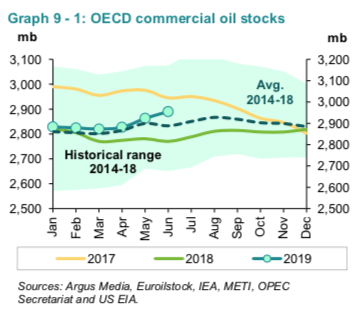
Why aren’t oil prices rising and oil inventories falling, if oil production has fallen?
The basic issue is that the economy is very much interconnected under the laws of physics, because energy is required for every activity that is considered part of GDP. Energy is required for any kind of heat or any kind of movement. Energy is even required for electricity. Without energy from the sun, food can’t grow; without supplemental energy of some kind (such as using electricity to heat an electric stove or burning animal dung or sticks), it becomes impossible to cook food or smelt metals.
…click on the above link to read the rest of the article…


